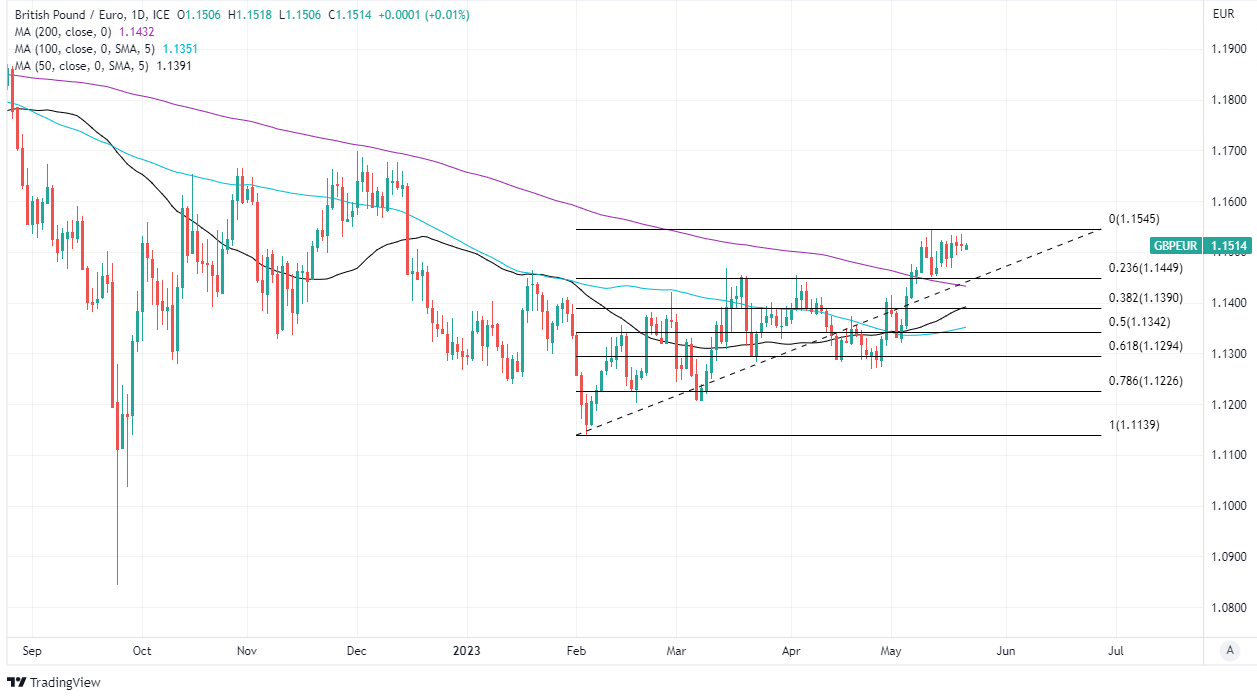GBP/EUR Week Ahead Forecast: Breaking Higher if UK Inflation Falls
- Written by: James Skinner
-
- GBP/EUR supported near 1.1448 & 1.1432 short-term
- Potential for break above resistance at 1.15 on charts
- If UK inflation relents or other data surprises positively
- Losses below 1.14 if inflation sticks near double-digits
- S&P PMIs, BoE chatter & UK retail sales also in focus

Image © Adobe Images
The Pound to Euro exchange rate's five-week rally has been hindered by a dense pocket of resistance on the charts in recent trade but it could get an opportunity to break above and beyond 1.15 this week if Sterling gains salvation from inflation, or if other UK data surprise strongly.
Sterling opened the new week near six-month highs in relation to the Euro following five weeks of gains that have seen it overcome two major moving averages on the weekly charts to begin eroding a formidable Fibonacci resistance now sitting immediately overhead at 1.1518.
A low-tempo performance from the single currency has helped to keep the Pound to Euro rate afloat within a narrow range near the 1.15 level in recent sessions but it's an imminent deluge of UK economic data that would be most likely to provide the inspiration for any break higher this week.
"There will be plenty of survey data reports coming our way in the week ahead. Chief among them is the flash May PMI report. We see services PMI slowing a touch in April to 55.6, as consumer spending starts to normalise a little after a surprise surge in March," says Sanjay Raja, an economist at Deutsche Bank.
"One key thing to watch out for here will be the price data – particularly for the services sector. Last month's PMI report showed a surprise jump in output prices," Raja and colleagues write in a Friday research briefing.

Government borrowing figures and the latest S&P Global PMI surveys of manufacturing and services sectors in the UK and Europe are the first installments of market-relevant economic data this week, and will be scrutinised closely in detail by economists.
This is after last month's surveys warned of a deepening downturn in the UK manufacturing sector that was counterbalanced somewhat by a surprise uptick in activity within the breadwinning services sector, although these are merely a warm-up act ahead of Wednesday's inflation report.
"We expect the May flash composite PMI to tick lower to 54.6 (-0.3), due to a deceleration in services to 55.5 (-0.4) as higher mortgage rates feed through into incrementally lower discretionary consumption," says Abbas Khan, an economist at Barclays.
The risk for the Pound to Euro rate is that Tuesday brings with it a sad set of business surveys to leave Sterling on the back foot ahead of the April inflation reading, which is likely to be a binary arbiter of the outlook for the currency over the coming weeks and months.
The worst possible outcome for Sterling might involve glum business surveys warning of a softening economy and above-consensus inflation that leaves prices growing at or still near a double-digit percentage rate.
Above: Quantitative model estimates of ranges for this week. Source Pound Sterling Live.
"We expect April’s consumer prices report to show that the headline rate of CPI inflation fell to 8.3% in April, below the MPC’s 8.4% forecast," says Samuel Tombs, chief UK economist at Pantheon Macroeconomics.
"Meanwhile, we think that services CPI inflation held steady at 6.6% in April, undershooting the MPC’s 6.7% forecast," Tombs adds.
Most economist forecasts suggest inflation will fall sharply on Wednesday and further than has been anticipated by the Bank of England but if they're wrong then the BoE would potentially be compelled to take even more aggressive interest rate action with adverse implications for the economy and Sterling.
However, on the other side of the same coin, if Wednesday's data does suggest the beginning of a meaningful and sustained retrenchment of price pressures then it would portend an eventual recovery of lost purchasing power, and so could be beneficial for the UK economy and Pound.
"A potentially sharp slowdown of inflation in the months ahead would be welcome news for the consumer, and for policy makers who are having to maintain a degree of hawkishness as long as inflation prints stay sticky," says Dominic Bunning, European head of FX research at HSBC.
"In our view, as long as the majority of the easing of inflation pressures is coming through the supply side, then it should be seen as a positive for EUR and GBP," Bunning writes in a mid-month forecast review.
Wednesday’s inflation data is the highlight of the week for Sterling but is followed by two public appearances from BoE Governor Andrew Bailey on the same day, while bookended by the S&P Global PMI surveys on Tuesday and retail sales figures for April on Friday.
Each of these could impact sentiment about UK economic prospects and appetite for the Pound, although the retail sales data will be watched most closely for the official insights it provides on consumer sentiment and spending.
"The FX upside from rising consumer confidence tends to lag by a few months, so the recent improvement in the mood of the consumer could continue to drive currency gains in the months ahead," Bunning says.
"If we continue to see some mean reversion – which is likely due to resilient wage gains and signs of peaking price pressures – then it should allow both EUR and GBP to benefit further," he adds.

